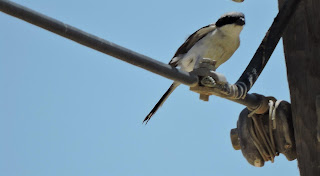A word of caution to birders. Rahab is just west of the main oil producing area of Oman where photography is not advised. Birding and photography directly on the main road including near Rahab is also prohibited. Nevertheless I judged Rahab farm, the surrounding area and Rabab village to be acceptable locations.
My reason for birding the area was based on intelligent guesswork. Pharaoh eagle owl is a rare but widespread resident in Oman. Furthermore there are more records in the north of the country than in the south. However the official Oman bird list shows a picture of one in Rahab farm albeit 13 years ago. The area was worth a look.
One obvious drawback is that Rahab farm used to be a fodder farm with more open access. Now it is a palm plantation and is closed. Looking over the fences produced no good sightings of birds.
400 metres away and south of the main road is a hill ridge which looked promising for owls.
Sure enough while clambering around the ridge I came across an owl. However it wasn't a pharaoh eagle owl but it was a little owl.
little owl
little owl at first sight
It was so light both in absolute terms and relative to the birds I have seen south of the mountains that it must be a candidate for the lilith sub species. This is called lilith owlet by some. Most little owl in Oman are assumed to be of the saharae sub-species. In a personal communication with Jnes Eriksen who is the Oman bird recorder this is the lightest little owl he has been presented with in the country.
little owl sideways
The rock formations in the hillside ridge where ideal for small indentations and I found three obvious breeding places in one small area.
a large indent
kestrels' nest
A second indeed also had guano and two kestrel constantly flying in and out. There was no doubt about this one.
one of the visiting kestrel
The third nest was also on the same side of the ridge.
nest site
My best guess for this one is for brown-necked raven.
mixed doves at Rahab
A little earlier I had birded in Rahab village itself. The area around the camel pens and at a watering point held almost all the birds. A significant proportion of the collared doves were African collared dove. For example in the picture above from the left numbers 1,4,5,6 are African collared dove, 2 is European collared dove and 3 is European turtle dove.
African collared dove
I understand Rahab is the furthest east than African collared dove has been observed in Oman though the original sightings were at a wadi between Thumrait and Marmul i.e not far away.
European turtle dove
This was also another desert village where European turtle dove is thriving.
brown-necked raven
A peculiarity of the village was the number of brown-necked raven. I don't usually associate this species with human habitation. Though they were mostly next to the camel pens rather than the houses.
brown-necked raven
Other birds included house sparrow and Arabian grey shrike.
Arabian grey shrike
The next day Saturday was the "global big day" for birding. I don't normally bird on Saturdays but an invitation to join a pelagic on this important day was too good to turn down. The trip was very successful too. I will blog about that next.














No comments:
Post a Comment